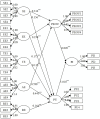The impact of AR online shopping experience on customer purchase intention: An empirical study based on the TAM model
- PMID: 39186502
- PMCID: PMC11346642
- DOI: 10.1371/journal.pone.0309468
The impact of AR online shopping experience on customer purchase intention: An empirical study based on the TAM model
Abstract
Augmented Reality (AR) offers a rich business format, convenient applications, great industrial potential, and strong commercial benefits. The integration of AR technology with online shopping has brought tremendous changes to e-commerce. The Technology Acceptance Model (TAM) is a mature model for assessing consumer acceptance of new technologies, and applying it to evaluate the impact of AR online shopping experiences on consumer purchase intention is an urgently needed area of research. Firstly, the typical applications of AR in online shopping were reviewed, and the connotations and experiences of AR online shopping were summarized. Secondly, using the five types of AR online shopping experiences as antecedent variables, and perceived ease of use and perceived usefulness as intermediate variables, a theoretical model was constructed to explore the impact of AR online shopping experiences on customer purchase intentions, followed by an empirical study. Finally, suggestions were proposed for optimizing the online shopping experience to enhance purchase intentions. The article expands the application scenarios of the Technology Acceptance Model and enriches the theory of consumer behavior in Metaverse e-commerce.
Copyright: © 2024 Guo, Zhang. This is an open access article distributed under the terms of the Creative Commons Attribution License, which permits unrestricted use, distribution, and reproduction in any medium, provided the original author and source are credited.
Conflict of interest statement
The authors have declared that no competing interests exist.
Figures




Similar articles
-
The Effect of Augmented Reality on Consumer Learning for Search and Experience Products in Mobile Commerce.Cyberpsychol Behav Soc Netw. 2020 Nov;23(11):800-805. doi: 10.1089/cyber.2020.0057. Epub 2020 Aug 14. Cyberpsychol Behav Soc Netw. 2020. PMID: 32799542
-
Investigating the acceptance intentions of online shopping assistants in E-commerce interactions: Mediating role of trust and effects of consumer demographics.Heliyon. 2024 Jan 24;10(3):e25031. doi: 10.1016/j.heliyon.2024.e25031. eCollection 2024 Feb 15. Heliyon. 2024. PMID: 38318071 Free PMC article.
-
A retentive consumer behavior assessment model of the online purchase decision-making process.Heliyon. 2021 Oct 13;7(10):e08169. doi: 10.1016/j.heliyon.2021.e08169. eCollection 2021 Oct. Heliyon. 2021. PMID: 34754967 Free PMC article.
-
Consumers' Decision-Making Process on Social Commerce Platforms: Online Trust, Perceived Risk, and Purchase Intentions.Front Psychol. 2020 May 15;11:890. doi: 10.3389/fpsyg.2020.00890. eCollection 2020. Front Psychol. 2020. PMID: 32499740 Free PMC article. Review.
-
Supermarkets in Cyberspace: A Conceptual Framework to Capture the Influence of Online Food Retail Environments on Consumer Behavior.Int J Environ Res Public Health. 2020 Nov 20;17(22):8639. doi: 10.3390/ijerph17228639. Int J Environ Res Public Health. 2020. PMID: 33233798 Free PMC article. Review.
References
-
- Jung TH, Bae S, Moorhouse N, Kwon O. The impact of user perceptions of AR on purchase intention of location-based AR navigation systems. J Retailing Consum Serv. 2021; 61:102575. doi: 10.1016/j.jretconser.2021.102575 - DOI
-
- Tam C, Loureiro A, Oliveira T. The individual performance outcome behind e-commerce. Internet Res. 2020; 30(2): 439–462. doi: 10.1108/INTR-06-2018-0262 - DOI
-
- Xu XY, Jia QD, Tayyab SMU. Exploring the stimulating role of augmented reality features in E-commerce: A three-staged hybrid approach. J Retailing Consum Serv. 2024; 77:103682. doi: 10.1016/j.jretconser.2023.103682 - DOI
-
- Oyman M, Bal D, Ozer S. Extending the technology acceptance model to explain how perceived augmented reality affects consumers’ perceptions. Comput Hum Beha. 2022; 128(3):107127. doi: 10.1016/j.chb.2021.107127 - DOI
-
- Trivedi J, Kasilingam D, Arora P, Soni S. The effect of augmented reality in mobile applications on consumers’ online impulse purchase intention: the mediating role of perceived value. J Consum Behav. 2022; 21(4): 896–908. doi: 10.1002/cb.2047 - DOI
MeSH terms
LinkOut - more resources
Full Text Sources
Research Materials

